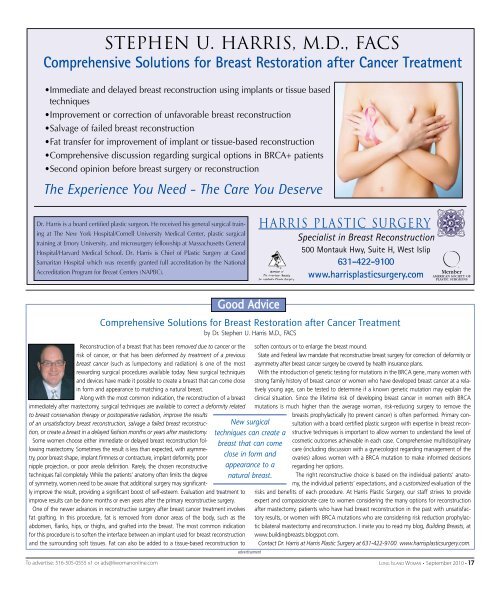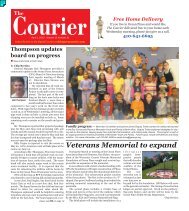Create successful ePaper yourself
Turn your PDF publications into a flip-book with our unique Google optimized e-Paper software.
Stephen U. Harris, M.D., FACS<br />
Comprehensive Solutions for Breast Restoration after Cancer Treatment<br />
•Immediate and delayed breast reconstruction using implants or tissue based<br />
techniques<br />
•Improvement or correction of unfavorable breast reconstruction<br />
•Salvage of failed breast reconstruction<br />
•Fat transfer for improvement of implant or tissue-based reconstruction<br />
•Comprehensive discussion regarding surgical options in BRCA+ patients<br />
•Second opinion before breast surgery or reconstruction<br />
The Experience You Need - The Care You Deserve<br />
Dr. Harris is a board certified plastic surgeon. He received his general surgical training<br />
at The New York Hospital/Cornell University Medical Center, plastic surgical<br />
training at Emory University, and microsurgery fellowship at Massachusetts General<br />
Hospital/Harvard Medical School. Dr. Harris is Chief of Plastic Surgery at Good<br />
Samaritan Hospital which was recently granted full accreditation by the National<br />
Accreditation Program for Breast Centers (NAPBC).<br />
HARRIS PLASTIC SURGERY<br />
Specialist in Breast Reconstruction<br />
500 Montauk Hwy, Suite H, West Islip<br />
631-422-9100<br />
www.harrisplasticsurgery.com<br />
Member<br />
AMERICAN SOCIETY OF<br />
PLASTIC SURGEONS<br />
Comprehensive Solutions for Breast Restoration after Cancer Treatment<br />
by Dr. Stephen U. Harris M.D., FACS<br />
Reconstruction of a breast that has been removed due to cancer or the<br />
risk of cancer, or that has been deformed by treatment of a previous<br />
breast cancer (such as lumpectomy and radiation) is one of the most<br />
rewarding surgical procedures available today. New surgical techniques<br />
and devices have made it possible to create a breast that can come close<br />
in form and appearance to matching a natural breast.<br />
Along with the most common indication, the reconstruction of a breast<br />
immediately after mastectomy, surgical techniques are available to correct a deformity related<br />
to breast conservation therapy or postoperative radiation, improve the results<br />
of an unsatisfactory breast reconstruction, salvage a failed breast reconstruction,<br />
or create a breast in a delayed fashion months or years after mastectomy.<br />
Some women choose either immediate or delayed breast reconstruction following<br />
mastectomy. Sometimes the result is less than expected, with asymmetry,<br />
poor breast shape, implant firmness or contracture, implant deformity, poor<br />
nipple projection, or poor areola definition. Rarely, the chosen reconstructive<br />
techniques fail completely. While the patients’ anatomy often limits the degree<br />
of symmetry, women need to be aware that additional surgery may significantly<br />
improve the result, providing a significant boost of self-esteem. Evaluation and treatment to<br />
improve results can be done months or even years after the primary reconstructive surgery.<br />
One of the newer advances in reconstructive surgery after breast cancer treatment involves<br />
fat grafting. In this procedure, fat is removed from donor areas of the body, such as the<br />
abdomen, flanks, hips, or thighs, and grafted into the breast. The most common indication<br />
for this procedure is to soften the interface between an implant used for breast reconstruction<br />
and the surrounding soft tissues. Fat can also be added to a tissue-based reconstruction to<br />
Good Advice<br />
New surgical<br />
techniques can create a<br />
breast that can come<br />
close in form and<br />
appearance to a<br />
natural breast.<br />
advertisement<br />
soften contours or to enlarge the breast mound.<br />
State and Federal law mandate that reconstructive breast surgery for correction of deformity or<br />
asymmetry after breast cancer surgery be covered by health insurance plans.<br />
With the introduction of genetic testing for mutations in the BRCA gene, many women with<br />
strong family history of breast cancer or women who have developed breast cancer at a relatively<br />
young age, can be tested to determine if a known genetic mutation may explain the<br />
clinical situation. Since the lifetime risk of developing breast cancer in women with BRCA<br />
mutations is much higher than the average woman, risk-reducing surgery to remove the<br />
breasts prophylactically (to prevent cancer) is often performed. Primary consultation<br />
with a board certified plastic surgeon with expertise in breast reconstructive<br />
techniques is important to allow women to understand the level of<br />
cosmetic outcomes achievable in each case. Comprehensive multidisciplinary<br />
care (including discussion with a gynecologist regarding management of the<br />
ovaries) allows women with a BRCA mutation to make informed decisions<br />
regarding her options.<br />
The right reconstructive choice is based on the individual patients’ anatomy,<br />
the individual patients’ expectations, and a customized evaluation of the<br />
risks and benefits of each procedure. At Harris Plastic Surgery, our staff strives to provide<br />
expert and compassionate care to women considering the many options for reconstruction<br />
after mastectomy, patients who have had breast reconstruction in the past with unsatisfactory<br />
results, or women with BRCA mutations who are considering risk reduction prophylactic<br />
bilateral mastectomy and reconstruction. I invite you to read my blog, Building Breasts, at<br />
www.buildingbreasts.blogspot.com.<br />
Contact Dr. Harris at Harris Plastic Surgery at 631-422-9100. www.harrisplasticsurgery.com.<br />
To advertise: 516-505-0555 x1 or ads@liwomanonline.com LONG ISLAND WOMAN • September 2010 • 17

















